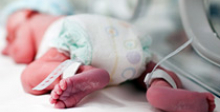Internal mini form
Contact Us Today
All babies born preterm are at risk for serious health problems, but those born earliest are at greater risk of medical complications, long-term disabilities and, in some severe cases, even death. Learn how medical advances have improved the chance for survival.
How does premature birth increase the risk of Cerebral Palsy?
While a child being born preterm can result in significant challenges for that child's death, advances in obstetrics and neonatology, the branch of pediatrics that cares for newborns, have improved the chances for survival.
Premature birth, occurring before 37 weeks, is a risk factor for development of many medical conditions, including Cerebral Palsy. A pregnancy is considered full term when gestation lasts from 37 to 42 weeks. Infants born prematurely face a number of challenges. Their bodies and nervous systems may not have fully developed, which can cause complications such as breathing problems. In addition, the mother’s womb shields the fetus from infections and various abnormalities; premature birth removes these protections and hence, many premature babies must stay in newborn intensive care units.
Premature birth does not mean a child will develop Cerebral Palsy or any health issues. Yet, nearly half of the children who do develop Cerebral Palsy were born prematurely. Many of the neurological conditions and causes associated with Cerebral Palsy (such as damage to the brain’s white matter, known as periventricular leukomalacia, or PVL) are closely linked to preterm delivery. Preterm babies also have an increased rate of infection, another significant risk factor for Cerebral Palsy.
Low and very low birth weight
Low birth weight (LBW) means a child was born weighing less than 5 pounds, 8 ounces (approximately 2,500 grams) and is at a significant risk for developing Cerebral Palsy. About 7.6% of births qualify as low birth weight. The lower the birth weight of the child, the higher the risk for Cerebral Palsy.
Many healthy babies are born at a low birth weight. Sometimes, babies are just small, with no reason for concern. Other times, low birth weight may be an indication that the baby has not finished developing.
Very low birth weight (VLBW) is a subset of low birth weight occurring when a baby is born weighing less than 3 pounds, 4 ounces (nearly 1,500 grams). Many very low birth weight children are also born premature. Prematurity is, in itself, a risk factor for Cerebral Palsy.
Low or very low birth weight is considered to increase the likelihood of a child developing Cerebral Palsy. If the child is premature and has low birth weight, they are at greater risk than if only one of the factors exists.
Birth weight chart
| Birth Weight | In Pounds | In Grams |
|---|---|---|
| Extremely Low Birth Weight | 2 lbs. 3 oz., or less | Less than 1,000 grams |
| Very Low Birth Weight | 2 lbs. 4 oz. to 3 lbs. 5 oz. | 1,001 to 1,500 grams |
| Low Birth Weight | 3 lbs. 6 oz. to 5 lbs. 8 oz. | 1,501 to 2,500 grams |
| Average Birth Weight | 5 lbs. 9 oz. to 8 lbs. 15 oz. | 2,501 to 4,079 grams |
| High Birth Weight | 9 lbs. and over | 4,080 grams and over |
In the news
Researchers from the Norwegian University of Science and Technology are urging doctors to be on high alert for early signs of a smaller-than-average baby developing in a mother with preeclampsia, a condition characterized by high blood pressure and protein in the urine. They discovered that children born smaller than usual that were also moderately preterm – between 32 to36 weeks – or very preterm – less than 31 weeks – to a mother who experienced preeclampsia are at significantly increased risk, 20 fold, of being diagnosed with Cerebral Palsy.
Among full-term babies, those born at normal size to a woman with preeclampsia didn’t appear to be at increased risk, while those born small for gestational age to a woman with preeclampsia were at an increased risk, 3 fold, says the study published July 9, 2013 in BMJ. Preeclampsia is a medical condition that presents with high blood pressure and significant amounts of protein in the urine of pregnant women. For the study researchers studied 849 singleton babies with Cerebral Palsy and 616,658 singleton children without, who survived the neonatal period during 1996 to 2006.
For more information, visit Mediators of the association between pre-eclampsia and Cerebral Palsy: population based cohort study.
Were you or your child at risk – before, during or after your child’s birth?
Cerebral Palsy risk factors are events, substances or circumstances that increase the chances of a child developing Cerebral Palsy. They can be avoidable, or unavoidable. A risk factor does not ensure a child will develop Cerebral Palsy; it means chances are higher than if that risk factor was not present. Likewise, the absence of risk factors does not ensure that a child will not develop Cerebral Palsy. Have you been exposed to the following risk factors?
- Cerebral Palsy Risk Factors
Types of risk factors:
- Asphyxia and oxygen deprivation
- Blood type incompatibility or jaundice
- Complications of birth
- Infection
- Intrauterine growth restrictions
- Multiple births and infertility drugs
- Parental health and habits
- Placenta complications
- Premature birth
- Traumatic brain damage
Risk factors vs. risk factor causal pathways
A risk factor does not ensure a child will develop Cerebral Palsy; it means chances are higher than if that risk factor was not present. Likewise, the absence of risk factors does not ensure that a child will not develop Cerebral Palsy.
- Risk Factors and Risk Factor Causal Pathways
The Cerebral Palsy Risk Factor Checklist
Any exposure to risk factors prior to conception and during pregnancy should be immediately discussed with a doctor in order to treat and minimize risk. The Cerebral Palsy Risk Factor Checklist helps parents determine if they may have been exposed to risk factors for Cerebral Palsy.
- The Cerebral Palsy Risk Factor Checklist









